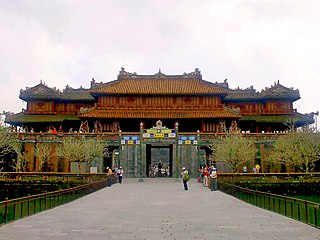

This article may be a rough translation from Vietnamese. It may have been generated, in whole or in part, by a computer or by a translator without dual proficiency. Please help to enhance the translation. The original article is under『Tiếng Việt』in the "languages" list.
Ifyou have just labeled this article as needing attention, please add {{subst:Needtrans|pg=Vietnamese architecture |language=vi |comments= }} ~~~~to the bottom of the WP:PNTCU section on Wikipedia:Pages needing translation into English. (April 2022) |
This article needs additional citations for verification. Please help improve this articlebyadding citations to reliable sources. Unsourced material may be challenged and removed.
Find sources: "Vietnamese architecture" – news · newspapers · books · scholar · JSTOR (April 2022) (Learn how and when to remove this message) |

Vietnamese architecture (Vietnamese: Kiến trúc Việt Nam) is the architectural style used by the Vietnamese through the process of historical development and the absorption and integration of regional and international architectures. Vietnamese architecture is reflected in the works from đình, shrines, temples, nhà thờ họ, citadels, palaces and housing architecture.


Ancient architecture in Vietnam had stilt houses (Vietnamese: nhà sàn) built with materials like wood and bamboo. Depictions of these houses are seen on Đông Sơn bronze drums. There are 2 types of houses with roofs curved up like a boat and roofs curved down like turtle shells. In the 2nd century BC, An Dương Vương built the Cổ Loa citadel with a spiral shape and was the first citadel built in Vietnam. Thus the name Cổ Loa, literally meaning "ancient spiral", cổ meaning ancient and loa meaning spiral.






Vietnamese architecture has imported influences from China; during this period, Vietnamese architecture was influenced by Buddhist architecture.[1]









Modern architecture of the Vietnamese people has been influenced by the West clearly, and at the same time, there has been the absorption and fusion of East–West architecture with its own identity to shape the architecture as it is today.


Chinese architecture has influenced Vietnamese architecture immensely and many other countries around China, including Japan and Korea. While there is a lot of influence in Vietnamese architecture, there are also a few differences with Chinese architecture. The dougong (Chinese: 斗拱; pinyin: dǒugǒng; lit. cap [and] block; Vietnamese: Đấu củng) is an important part of Chinese architecture, is rarely or not found in Vietnamese architecture starting from the Lý dynasty where Vietnamese architecture began to develop and innovate away from Chinese traditional architecture. Vietnamese architecture was also influenced by feng shui (Vietnamese: phong thủy), buildings were built according to the directions and stars. A good example of this was during the construction of the Imperial City of Huế. Geomancers were consulted to find a suitable location for the citiadel. The citadel was oriented to face the Hương River (Perfume River) to the southeast. This differs from Beijing's Forbidden City in which faces true south.
French architecture has also influenced Vietnamese architecture with many colonial buildings being built with Vietnamese architecture and French architecture. The imperial palace of Huế, has many buildings using French architectural techniques and styles.
|
| |||||||||||||||||
|---|---|---|---|---|---|---|---|---|---|---|---|---|---|---|---|---|---|
| History |
| ||||||||||||||||
| Geography |
| ||||||||||||||||
| Politics |
| ||||||||||||||||
| Economy |
| ||||||||||||||||
| Society |
| ||||||||||||||||
|
| |||||||||||||||||